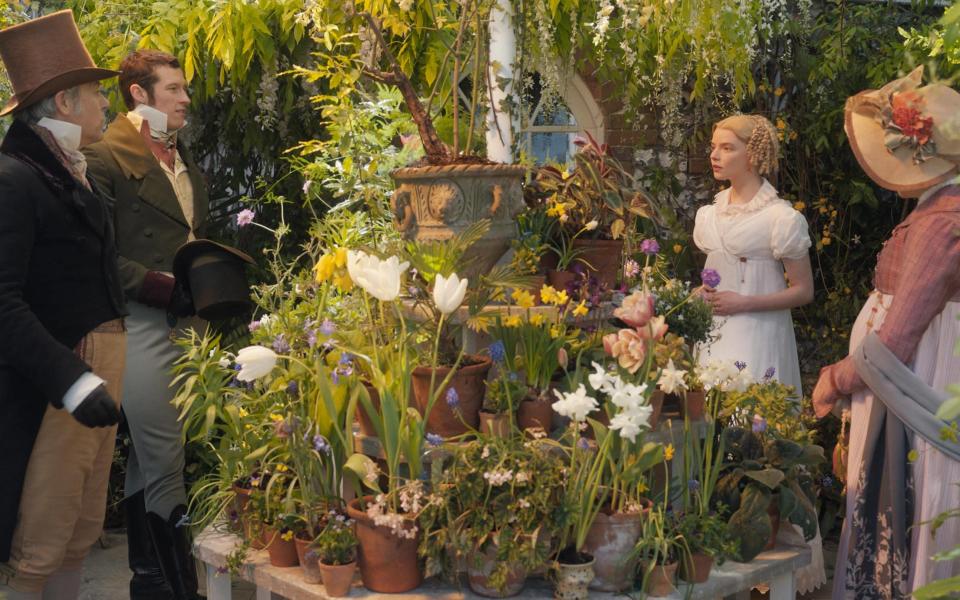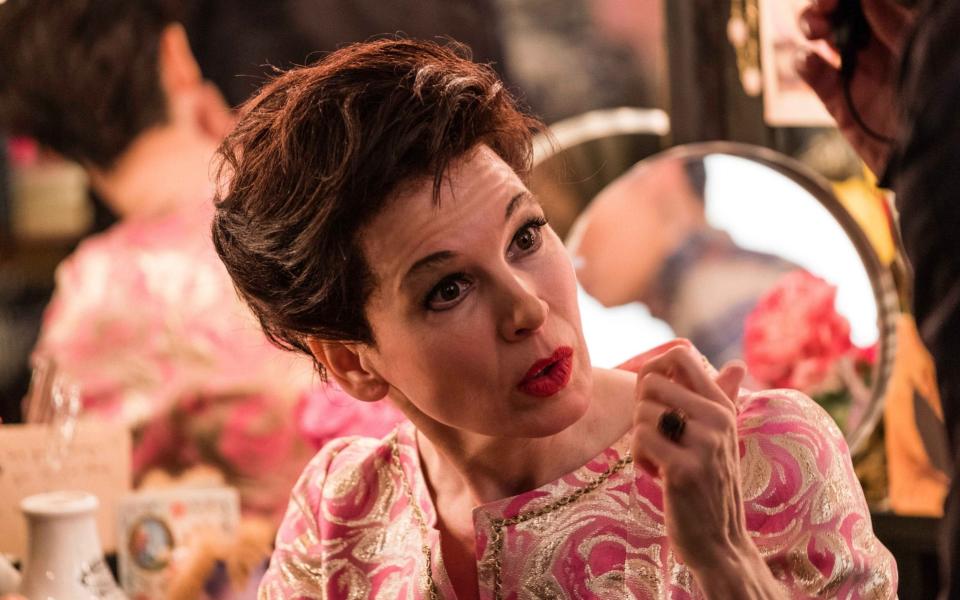The ultimate flower guide for a period-appropriate garden, according to film florist for Emma

In Autumn De Wilde’s film adaptation, Emma (played by Anya Taylor-Joy) favours blousy arrangements at Hartfield. In the opening greenhouse scene, cascading stems of sweet peas, jasmine and clematis hang softly. Hinting at the romance and humour yet to play out, Emma – ever the wild card – picks stems for a tussie-mussie (a posy of hand-tied plucked stems, popular at the time) decisively.
“Ensuring flowers are appropriate to the period is key: they tell their own quiet tales, illuminating the scenes,” says Gypsy Rose Flowers floral artist Tamsin Scott, the stylist responsible for creating the botanical backdrops in the film – out this week on DVD – alongside set decorator Stella Fox.
Fashion photographer Tim Walker has described Tamsin Scott as the Constance Spry to his Cecil Beaton (Spry the florist created the flowers for not only Beaton’s photographs, but also for the nuptials of the Prince of Wales and Wallis Simpson, the Queen’s coronation and for Fred Astaire and Ginger Rogers routines).
As well as telling the tale of Emma Woodhouse through blooms, in keeping with Georgian and Regency-era tastes, Scott is also responsible for the floral design in James Watkins’ Edwardian-era The Woman in Black and Pathé’s Oscar-winning Judy, starring Renée Zellweger (set in the Sixties) on the big screen.
A post shared by TAM SCOTT (@gypsyroseflowers) on Oct 1, 2019 at 7:42am PDT
The go-to designer for period dramas, her TV credits include ITV’s The Halcyon, in which screenwriter Charlotte Jones frames her examination of 1940s London around a glamorous five-star hotel, and the BBC’s Mapp and Lucia, based on the novels of E.F Benson set in the 1920s and 1930s - the era in which one of Scott’s favourite gardens, Vita Sackville-West’s Sissinghurst, was created.
“I’m a history lover, so I enjoy the research elements as much as being on set,” explains Scott. “For Emma, I thought about what would have realistically been planted in cottage or formal gardens, what was seasonal, and who would have had gardeners or picked flowers themselves. Hot houses and orangeries were increasingly popular at the time, so in the greenhouse scene I could select flowers cultivated to bloom either seasonally or earlier or later – giving me room to manoeuvre which wouldn’t have been the case if the film had been set one hundred years before.”

Emma is set in a period in which garden designers were blurring the boundaries between formal gardens and parks, in line with the Picturesque movement. Scott describes each of American fashion photographer and director Autumn de Wilde’s frames as “like a moving painting of the period”, from the rich wood panels to the candy-coloured walls of the tea party scenes.
“We had several different styles of properties to work with, so as well as immersing myself in Jane Austen’s books, I looked at contemporary gardens of the time, designed by Capability Brown and Humphrey Repton. Snooping around West Wycombe, Croome, Osterley Park, Audley End and Stowe gardens always give me good ideas for period planting,” she says.
“Cross-referencing old masters with British flower availability at the time is a fun exercise – I spent hours poring over contemporary paintings, sketches and ideas by Rachel Ruysch, Édouard Manet, Peter Casteels, John Constable, Ambrosius Bosschaert and Henri Fantin. Happily, they all loved painting flowers. Georgian wallpapers, clothes, china sets, fabrics and old millinery cards with pictures of bonnets also give away floral secrets.”
Scott’s other notable moments in the film include the ballroom scene, in which garlands complement the chairs, drapes and costumes. The table is adorned with hundreds of vases of English roses, tree peonies, larkspur snapdragons and sweet peas. In the Christmas dining scenes, dyed silk ribbons make fir garlands pop out from wood panels, while hellebores, anemones and berries glisten in candlelight. “Even though I’ve spent hours agonising over how they look, the sets need to feel like the outside has been brought indoors in a realistic way,” she says.

Of course, there were also two weddings for Scott to contend with: the first, the Weston wedding, is pretty yet scaled back. In contrast, when Emma gets married, the church is filled with “loads of delicious stuff, with total wild abandon. I’m sure Emma would have refused any offer of help, and I wanted to see her character come through.”
The task of filming within three months, covering four seasons authentically and sympathetically, was not without challenges. “Sets can get incredibly hot with lighting, so making sure what I was using was sturdy was essential. I had to have pristine back-up flowers for potential re-shoots. Rooms in old properties can be difficult to access, and sometimes we’re not allowed to have water, so I mix fresh foliage with silk flowers to make it work.”

For Scott, the flowers should be a backdrop to the story – not scene stealers, unless central to the plot. “I step back and think ‘what would Emma do here?’, or ‘what would Judy Garland be thinking?’ Would the maid have been lazy about flower arranging? Would a super fan send flowers every day to a dressing room? Is the master of the house trying to impress, or cut corners?” she explains. “For Judy, I looked at the iconic poppy field scenes in the 1939 film The Wizard of Oz. We put the poppies at different heights and the flowers make the young Judy look tiny.
"Her sorrowful dressing room scene has a backdrop of cast aside, showy but wilting gifted flowers and notes, reflecting how much people loved Judy Garland, but how little that came to matter to her.”

Scott also pored over Sixties film and interiors magazines and old Judy Garland footage, taking cues from other films such as A Hard Day’s Night (1964), Darling (1965) and The Pleasure Girls (1965) – referring to vintage Sixties seed catalogues with illustrations of popular flowers of the time, like pink dinner plate dahlias.
“In Judy, the flowers in the hotels are dramatic and grand. When she’s turned away because her bill hasn’t been paid, they are imposing, almost as though they’re telling her off. In the café scene with her agent, the place drips with roses and wealth. Everything about the set around her makes her ever-shrinking persona and finances seem smaller.
“I actually don’t think the Sixties was a particularly pretty period for flowers. They presented bouquets on vast sheaths of plastic back then. It brashly bridged the post-war era where there was a dearth of new flowers being imported and the 1970’s, where letting go and becoming wild both in life– and in our homes and gardens – was the order of the day.”

Another of Scott’s credits is Trust, an FX true-crime drama which follows the sprawling story of the Getty family dynasty. “Trust was set in the Sixties and Seventies. The arrangements were very angular, with dreamy scenes in front of lace curtains and boudoirs almost tutti-frutti in palette, and Seventies greenhouses filled with spider plants and a hazy atmosphere. There’s a gloomy funeral scene where we used black lilies to match the black swans,” she says.
“Last year, I worked on The Nest starring Jude Law, set in the Eighties – an opportunity to go very Laura Ashley. The Halcyon was set in the Second World War, but it was still important for the big hotels to exude glamour. As nothing was being imported, it was all about creating Hollywood pizzazz, while using British flowers.
"Recently, I also worked on Hulu’s American comedy-drama miniseries, The Great (now available to stream in the UK on StazPlay). Set in the 1740’s, it follows the rise of Catherine the Great, starring Elle Fanning and Nicholas Hoult. Those huge Russian palaces were filled with taxidermy and opulent flowers interspersed with feathers and general over-the-topness."
A post shared by TAM SCOTT (@gypsyroseflowers) on May 17, 2020 at 12:10pm PDT
Just as it is important to Tamsin to create a period appropriate set in keeping with the storyline in her work, she also suggests that homeowners and gardeners introduce elements in keeping with the period history of their own home. “We all love to make our own mark on our houses, but I think keeping a bit of history to a period property is key.
"My house was an old gardener’s cottage so it has that humble cottage garden element to it. I try to maintain that by introducing old-school flowers like sweeping foxgloves, lupins and larkspurs over stiff, formal planting.

"Some houses are so steeped in history, and, depending on the period, have been looked after by hundreds of years of gardeners before their current owners. I like to see a nod to all of these characters, but also showcase the latest trends of gardening, too. Audley End is a fantastic example of this
"From the walled garden that has gone from being just about growing produce to eat to being crammed with flowers, to a formal garden with little spikes of modern flowers, it's wonderful that each era makes its mark."
Emma is out now on DVD and Blu-Ray from Universal Home Entertainment

